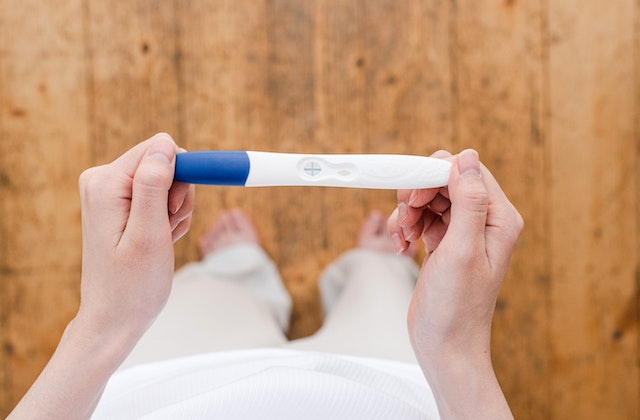
As an expectant parent, it’s natural to eagerly monitor your pregnancy progress by utilizing home pregnancy test kits to track your test line progression. These kits allow you to repeatedly check for the presence of a positive result, confirming whether your efforts to conceive have been successful.
Home pregnancy tests can sometimes be perplexing, especially if you’re testing in the early stages of pregnancy. However, they offer an affordable, user-friendly, and convenient method to determine what you’re expecting. But what exactly do those faint lines or plus signs indicate? Allow this guide to shed light on what you should know about pregnancy test line progression.
Understanding the interpretation of the test results is crucial, as it helps you accurately assess your pregnancy status. By gaining clarity on how to interpret the test lines or symbols, you can confidently navigate this exciting phase of your journey toward parenthood.
Pregnancy Test Lines
Pregnancy tests feature lines that serve specific purposes, ensuring accurate results and preventing misinterpretation. These lines play a crucial role in guiding you through the testing process.
The primary window on the test, known as the test indicator window, typically contains two lines. The first line is called the control line. This is a reference point to confirm that the test is functioning correctly. The presence of the control line indicates that the test is valid.
The second line, often referred to as the pregnancy test line, appears only if you are pregnant. Its appearance confirms a positive result, indicating that pregnancy has been detected. In some tests, the control line and the pregnancy test line are displayed in separate windows, each serving its purpose. The instructions provided with the test will clarify which line corresponds to the control line.
Understanding the significance of these lines and following the instructions carefully will help you accurately interpret the test results. It will also provide you with valuable information about your pregnancy status.
How Does a Pregnancy Test Work?
Home pregnancy tests are designed to detect the presence of human chorionic gonadotropin (hCG). This is a hormone produced during pregnancy. When hCG is detected in urine, the test will yield a positive result, indicating pregnancy. Conversely, if no hCG is present, the test will produce a negative result.
Typically, a positive result is represented by two lines displayed either side by side or enclosed in a plus sign. However, it’s important to note that the accuracy of the test results relies on following the instructions correctly. In a review study conducted in 1982, it was found that only one-third of users read the test instructions. Consequently, false negative results were observed in approximately 25% of cases during that time.
Fortunately, with advancements in technology and increased awareness, the reliability of pregnancy tests has significantly improved. As of the early 1990s, around 76% of users reported reading the test instructions. This led to enhanced testing reliability with a sensitivity rate of 99% for early detection.
By carefully reading and following the test instructions, you can maximize the accuracy of the results. This ensures a more reliable outcome when using a home pregnancy test.
What Does A Faint Pregnancy Test Line Progression Look Like?
Depending on the specific pregnancy test you use, the results may be indicated by a plus or minus sign, or more commonly, one or two lines displayed in the result window.
It is crucial to carefully read and follow the instructions provided with the pregnancy test kit. This is to understand the specific indicators you should be looking for.
In the early stages of pregnancy, if you are indeed pregnant, the line or double line on the test may appear faint. It resembles a subtle chalk smudge. This is because the pregnancy hormones are still developing. However, as your pregnancy progresses and hormone levels increase, the line or lines may become more distinct, resembling marks made with a sharpie.
Remember, the clarity of the lines may vary depending on the sensitivity of the test. Also the stage of your pregnancy. Always refer to the instructions to properly interpret the results. Consult with a healthcare professional if you have any questions or concerns.
What Does A Very Faint Line On A Pregnancy Test Mean?

When you observe a very faint line on a pregnancy test, it indicates that implantation has already occurred, and you are in the early stages of pregnancy. However, it is advisable to recheck the test after a few days or weeks to see if the line has become thicker and darker.
If the line does become more pronounced, it signifies that your pregnancy is progressing, bringing a sense of joy and hope. It’s important to note that experiencing a period a few weeks after seeing a faint line on a pregnancy test does not necessarily mean you were not pregnant or that the pregnancy was brief.
While a faint line can sometimes have links with a chemical pregnancy, it does not automatically invalidate the test. Additionally, it could indicate other early pregnancy losses or the possibility of an ectopic pregnancy.
Although this can be a disheartening experience, it is important to remember that without the faint line alerting you, you may not have been aware of what had happened. It does not affect your ability to conceive in the future and can even be seen as evidence of your fertility.
To confirm your pregnancy, it is advisable to schedule an appointment with your OB/GYN and undergo a blood pregnancy test. This test measures your hCG levels, providing your doctor with valuable information to assess the progress of your early pregnancy.
Remember to seek support from your healthcare provider and loved ones during this time, as they can provide guidance and reassurance.
What Does A Positive Pregnancy Test Line Progression Result Look Like?
Although there are different types of test results, such as the digital ones that show the word “yes” or “pregnant” when they are positive. A positive pregnancy test result usually appears as a plus sign, two double lines, or one line in a results circle or window.
Common Errors
Before purchasing a pregnancy test, it’s important to check the expiration date. An expired test, although visually similar to a valid one, may provide inaccurate results. Additionally, the test’s instruction manual often includes sample images of different pregnancy test results.
When interpreting the results, it’s crucial to note that even a very faint line should be considered positive as long as it is not completely blank. To get a clearer view, you can try holding the pregnancy test against a white paper or a wall.
Some individuals choose to share photographs of their pregnancy tests on online forums, seeking feedback and support. If it brings you comfort and you are comfortable with sharing, feel free to do so. However, it’s important to be aware that anything posted online, even in private forums, can potentially be accessed by the general public.
It’s natural to feel uncertain or seek confirmation after reading your test results, especially if you are hoping to conceive. Remember to consult with a healthcare professional for accurate and reliable confirmation of your pregnancy.
Reasons Why A Pregnancy Test Could Be Getting Lighter

When it comes to interpreting home pregnancy test results, it’s common to have questions compared to tests performed at a doctor’s office. One important indicator on a home pregnancy test is the presence of two lines, regardless of how faint they may appear.
If you notice a lighter line today compared to a previous test, there’s no need to panic. It could simply be because your urine was more diluted, making it harder for the test to detect the pregnancy hormone hCG. For more accurate results, it’s recommended to retest in the morning when hCG levels are typically more concentrated.
It’s worth noting that different brands of pregnancy tests may have varying degrees of sensitivity, which can lead to different results. For a fair comparison, it’s advisable to use the same brand of test for consecutive tests.
If you notice that the line becomes lighter or disappears over a few days or weeks, there are two possible explanations:
- The initial result could have been an evaporation line, which is quite frustrating. Discover the difference between evaporation lines and faint positives.
- The pregnancy might be caused by chemicals. When an egg is fertilized but does not completely implant into the uterus, a chemical pregnancy occurs.
What If I Got A Positive Pregnancy Test Followed By My Period?
It is crucial to distinguish between your regular period and spotting, especially after a positive pregnancy test. Approximately 15% to 20% of pregnancies in the first trimester may experience spotting. This light bleeding, known as implantation bleeding, typically lasts for one to two days and is much lighter than a typical period.
Spotting occurs when the fertilized egg causes a small separation of the uterine lining during implantation, resulting in mild bleeding. It is considered a normal part of early pregnancy.
On the other hand, a chemical pregnancy can occur if you start your period shortly after a positive pregnancy test. A chemical pregnancy refers to an early miscarriage that happens when a fertilized egg fails to fully implant in the uterus. In this case, you may experience increased bleeding that resembles a regular menstrual period. If you retest and the result is negative, it may indicate a chemical pregnancy.
Remember this if you are experiencing a chemical pregnancy; studies suggest that after a chemical pregnancy, women may become more fertile. Natalist explains more about this study in Everything You Need to Know About Chemical Pregnancies.
What A Faint Line Means
While hCG levels typically increase during the early weeks of pregnancy, the darkness of the pregnancy test line may not necessarily correlate with the level of hCG. Various factors can influence the concentration of hCG in a urine sample, which can affect the intensity of the test line.
One crucial factor is the amount of urine in your system at a given time. Factors such as fluid intake and urination frequency throughout the day can impact the concentration of hCG in your urine. Consuming alcohol or urinating frequently can lower the concentration of hCG in your urine, potentially affecting the visibility of the test line.
If your urine is light or diluted, it may result in a less distinct line on a home pregnancy test. In contrast, testing with darker and more concentrated urine may yield a clearer line. However, using multiple tests to track the color intensity of the line is not a reliable method for monitoring the progression of early pregnancy. It’s important to note that even as the pregnancy advances and hCG levels increase, the test line may not always appear darker over time.
Remember, the most accurate way to confirm the progression of pregnancy is through consistent monitoring of hCG levels with the guidance of a healthcare professional. They can perform blood tests that provide a more precise measurement of hCG and offer a better understanding of your pregnancy’s development.
Change In Test Results

Receiving a negative result after receiving a positive result from a home pregnancy test can be a cause for fear and misunderstanding. It could be a false negative, which is typically the result of a user mistake, or it could be the consequence of a chemical pregnancy, a very early miscarriage.
A pregnancy is considered chemical before the fifth week of pregnancy and before the fetus can be seen on an ultrasound. Up to 25% of pregnancies that result in miscarriage are thought to be affected by it. The hCG levels in your blood may be checked more than once if a chemical pregnancy is suspected.
Can A Barely Visible Pregnancy Test Result Be Negative?
Since the pregnancy test detects hCG, the result of a barely visible pregnancy test is normally positive, but it may also represent a false positive or an early miscarriage. Another possibility is a false negative result.
Despite research showing they are much less reliable, women at home utilize home pregnancy tests in the real world. When examined by lab specialists under ideal settings, the majority of home pregnancy tests claim to be up to 99 percent accurate, and they probably are.
When a pregnancy test shows a faint line but you are not genuinely pregnant or have a nonviable pregnancy, examples include the following:
1. Menopause
When a woman in perimenopause or menopause misses her period and takes a pregnancy test, the results can occasionally (albeit infrequently) be positive because of abnormally high luteinizing hormone levels when taking fertility medicines and other prescription drugs.
Traces of fertility pills or other pharmaceuticals containing hCG may result in false positives, although this is unlikely. If you received an hCG injection as part of your fertility treatment, your levels may be elevated for at least seven days following even if you are not pregnant.
2. When You Lose A Pregnancy In The Early Stages
A recent chemical pregnancy, an ectopic pregnancy, or another early pregnancy loss are other possible causes of a false positive.
3. Illness
In extremely rare cases, some tumors that affect hormone production can cause a false-positive pregnancy test.
Reasons Your Pregnancy Comes Back Negative
Here’s why your pregnancy test can come back negative even if you may be pregnant:
1. Too Soon
The hCG concentrations are not yet measurable if you are very early in your pregnancy. Waiting a week before testing again is your best chance.
2. You Looked At The Outcomes Way Too Quickly
You may be impatient! To reveal findings, however, administer the test for the entire amount of time advised on the package directions. To be sure you’re waiting long enough, use the timer on your watch or a kitchen timer.
3. Your Urine Is Thin
The results can be unreliable if your urine is too diluted for the test to identify hCG. Although it’s frequently advised to take the test first thing in the morning when your pee is at its most concentrated.
This may not be necessary because contemporary pregnancy tests are extremely sensitive and may detect hCG at any time.
Also, the results of a home pregnancy test you used were inaccurate if you didn’t strictly adhere to the directions or if it was past its expiration date.
Conclusion
The intensity of the pregnancy test line should generally become darker as the pregnancy progresses. If you notice that the test line is getting lighter, there are a few possible explanations. One reason could be that you took the test after consuming a large amount of water, which can dilute your urine and affect the test results. Another possibility is that the initial test result was not actually positive, but rather an evaporation line, which can sometimes appear as a faint line due to the drying of the test.
When conducting early pregnancy testing and tracking the results over time, it is advisable to use the same type of test consistently. This can help ensure accurate comparisons and minimize any confusion or misinterpretation of the results.
It is important to note that spotting or experiencing a chemical pregnancy (early miscarriage) can still occur even after obtaining a positive pregnancy test result. While these early miscarriages usually do not require medical intervention, it is always a good idea to inform your doctor about any changes or concerns you may have regarding your pregnancy. They can provide guidance and support during this time.
Leave a Reply
You must be logged in to post a comment.